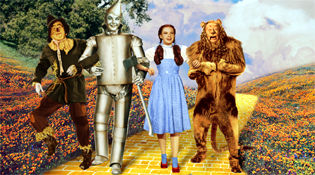Following the Yellow Brick Road, Part II
 I recently read this great book by Patrick Harpur called The Philosophers' Secret Fire: A History of the Imagination. The author, as an Amazon reader stated quite well, "revisits 'the Otherworld,' a realm of imagination—of mythology and folklore, metaphor and analogy, spirit and soul. It is a world celebrated by Plato and
I recently read this great book by Patrick Harpur called The Philosophers' Secret Fire: A History of the Imagination. The author, as an Amazon reader stated quite well, "revisits 'the Otherworld,' a realm of imagination—of mythology and folklore, metaphor and analogy, spirit and soul. It is a world celebrated by Plato andneo-Platonists; by shamans and soothsayers; by alchemists and magi; by mystics (Jacob Boehme and St. John of the Cross); by Romantic poets (William Blake, Samuel Taylor Coleridge, and W. B. Yeats); and by the psychologist C. G. Jung. [Yet] the burden of Harpur's message is that modern man has lost his soul. The spiritual hubris of his literalism, materialism, rationalism, and scientism has separated him not only from his own "soul, but also from Nature and from the 'World Soul,' which permeates the cosmos and which, in a pantheistic sense, is the cosmos." I would add that "modern man" in this context specifically refers to "Western man," given that the more "primitive" cultures remain ever in touch with "the Otherworld." While this tells you what The Philosophers' Secret Fire is about, it doesn't tell you how wonderfully written and what a pure joy it was to read. Honestly, it was one of the best, most delightful and most thought-provoking reads I've stumbled upon in recent years, so I really took notice when Harpur quoted some material from The Passion of the Western Mind by Richard Tarnas. Harpur generously commented that although he doesn't agree with everything Tarnas has to say, his work is worth reading. I duly noted that.
Meanwhile, during a mid-day break from my corporate life-sucking job, I spent some moments browsing the new titles section at Cody's Books on Union Square. One hefty volume caught my eye, a book entitled Cosmos and Psyche. The cover art was engaging, and the jacket marketing did its job. I scribbled the title down without making the connection between the author, Richard Tarnas, and the other book I'd recently added to my "to be read" list.
The connection might never have been made if it wasn't for an event notification that came to my inbox. Fields Book Store was announcing an upcoming reading by Richard Tarnas, who would be promoting his new book Cosmos and Psyche. The advertisement featured a big cover image, and I immediately recognized it as the book I'd picked up at Cody's. It was then that I also realized he was the same guy Harpur had mentioned. Owing to this series of "coincidences," I felt I had to go, so I marked my calendar and counted down the days.
Once there, I felt a sense of anticipation and wariness. I carefully scanned all the other people attending, I made eye contact with Tarnas himself during the reading, and I was prepared for something monumental to happen. Either something monumental did happen or, in my zealousness, it snuck past while my attention was diverted. I will say that Tarnas was a very good speaker, with an obvious following. I found his work to be tremendously appealing even if sometimes the sheer magnanimity of it was daunting, and despite the fact that I, like Harpur, wasn't totally convinced of Tarnas's main conclusion, which is that the next step of human evolution is upon us. (I know I haven't drawn that out in this or the previous post, but a google on Tarnas will yield all kinds of info). The only thing I can say is that given the subject matter, I expected some kind of synchronicity to propel me in new directions. Instead, I felt only a tiny little intuition that made no immediate sense.
The intution said to send my resume to Tarnas and to the book store. I have done neither. I don't know if I will comply or not. It feels a little foolish. Yet, I am a person who doesn't believe in coincidences as meaningless events. I am fairly convinced that in that sense, there is no such thing as a coincidence. This does not make me a fatalist per se, but I regard such moments as messages and like any message you can fail to answer the phone when it rings or hit delete without even looking at the email message. Without a doubt, the "intuition" in itself was a meaningful message, but I'm not sure if I want to open that envelope because even if I do, I might be unable to put the contents in meaningful context. Or they may require more of me that I may or may not be prepared to do. Or the envelope could be empty, which would be a disappointment. So for now, the tracks stop here.
Except for this one other thing: Most interesting of all is the fact that I'd never before received a mailing from Fields. I don't recall signing up for their announcement list and to be honest, I have never again received anything from them. I don't really know how to explan that one. So maybe I will send that resume. Can't hurt, I guess.
 On the Seal-Woman's Skin (The Princess and the Deer)
On the Seal-Woman's Skin (The Princess and the Deer) Today I went down
Today I went down